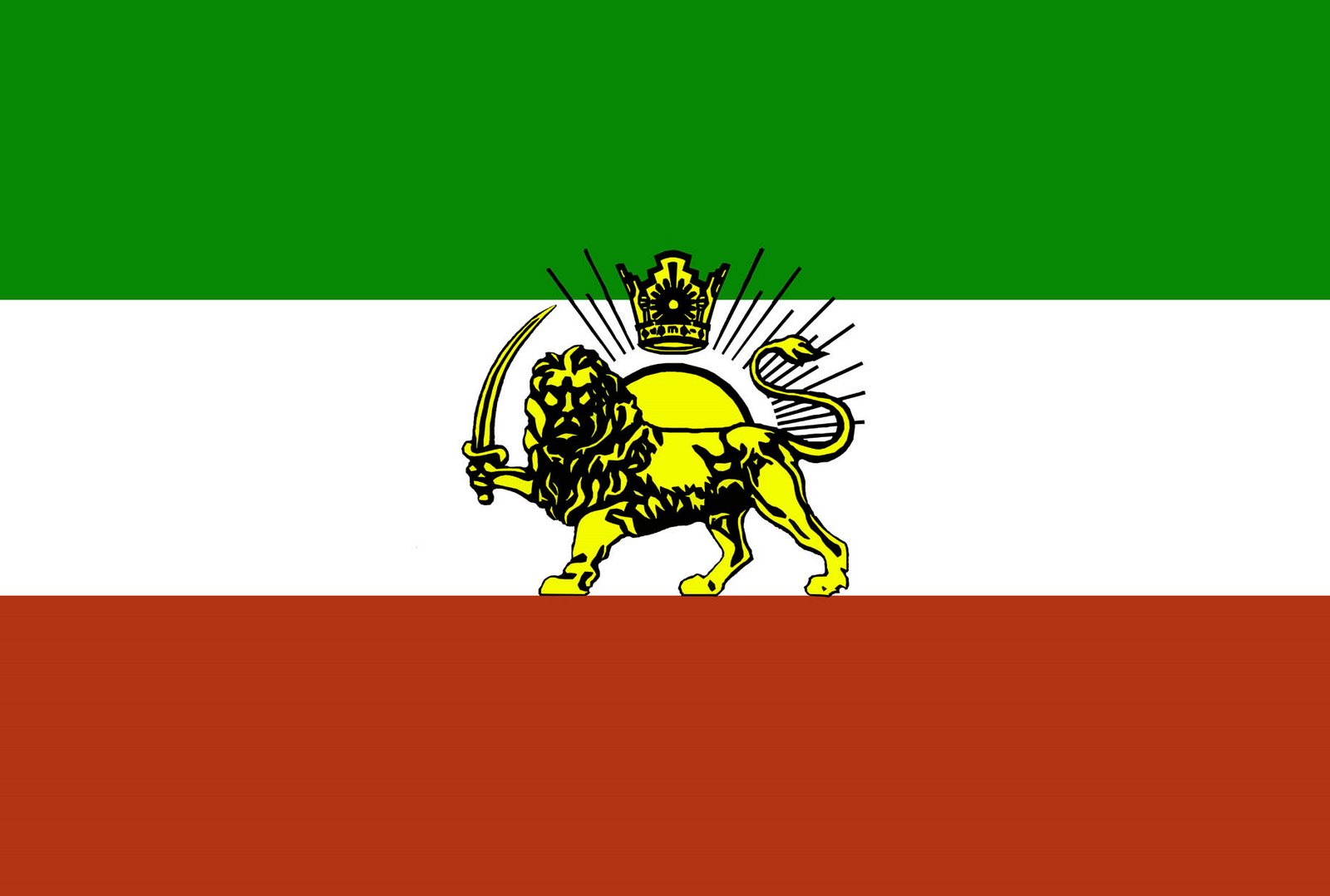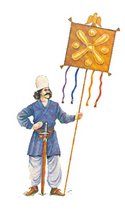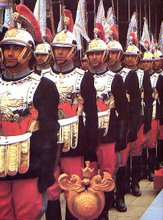
A Question of Numbers
August 08, 2003
Rouzegar-Now
Cyrus Kadivar
Source: Emad Baghi , Iran Emrooz (Persian)
Rumours, exaggerated claims by the leaders of the Islamic revolution and a disinformation campaign against the fallen monarchy, not to mention Western media reports that the imperial regime was guilty of "mass murders", has finally been challenged by a former researcher at the Martyrs Foundation (Bonyad Shahid). The findings by Emad al-Din Baghi, now a respected historian, has caused a stir in the Islamic republic for it boldly questions the true number of casualties suffered by the anti-Shah movement between 1963 and 1979.
In the aftermath of the fall of the Pahlavi dynasty in 1979, Ayatollah Khomeini, the leader of the Islamic revolution, ordered the creation of the Martyrs Foundation with the sole purpose of identifying the names of the so-called "martyrs" and provide financial support for their families as well as those who had sustained injuries in the fierce street battles with royalist troops. The necessary funds were immediately raised from the assets seized from the high officials in the Shah's regime, many of whom had been executed after summary trials.
For many years the Martyrs Foundation collected the names of the victims of the anti-Shah revolution classifying them by age, sex, education, profession and address. The files were kept secret until 1996/7 when a decision was made to make public the figures on the anniversary of the revolution. At about this time, Emad al-Dib Baghi, was hired as a researcher and editor of the bonyad's magazine "Yad Yaran" (Remembering our Comrades) to make sense of the data. By the time his work had finished he was told that the names were not to be made public. The reason given was that to pursue the matter would run contrary to the statements made by the late Ayatollah Khomeini and his successors who claimed that "60,000 men, women and children were martyred by the Shah's regime."
Emad al-Din Baghi who left the Martyrs Foundation to write two books on the subject claims that the authorities felt that releasing the true statistics would simply confuse the public. So, officials continued to stick to the exaggerated numbers. During a debate in the Majlis at the height of the US hostage crisis, an Islamic deputy claimed that giving in to America would be an insult to the memory of "70,000 martyrs and 100,000 wounded who fought to destroy the rotten monarchy." In fact, by continuing the myth that so many people had been killed, the regime was able to buy a certain legitimacy for its "noble revolution" and excesses.
"Sooner or later the truth was bound to come out," Baghi argued. In his opinion history should be based on objective findings and not baseless rumours which was the root of the anti-Shah hysteria and street demonstrations in 1978 and 1979. The true numbers are fascinating because contrary to the official view they are quite low and highly disproportionate to the hundreds of thousands murdered in the last 24 years in the Islamic republic.
The statistical breakdown of victims covering the period from 1963 to 1979 adds up to a figure of 3,164. Of this figure 2,781 were killed in nation wide disturbances in 1978/79 following clashes between demonstrators and the Shah's army and security forces. Baghi has no reason to doubt these figures and believes that it is probably the most comprehensive number available with the possible exception of a few names that were not traced.
During the years separating the arrest of Khomeini on 5th June 1963 for instigating the riots against the Shah's White Revolution and his return from exile on 1st February 1979, most of the 3,164 victims were in Tehran, Rey and Shemiran and 731 were killed in riots in the provinces which constitutes 14% of the country. Most of the casualties were in central Tehran and the poorer southern areas. Of this number 32 "martyrs" belong to the 1963 riots who were killed in 19 different parts of the Iranian capital. All were male and from southern Tehran.
Despite this revelation all officially sanctioned books in Iran dealing with the history of the Islamic revolution write of "15,000 dead and wounded". Such wild figures have found its way in Western accounts.
Another myth is the number of those killed on Friday, 8th September 1978 in the infamous Jaleh Square massacre. On that day the Iranian government imposed martial law in Tehran after troops had fired at several thousand anti-government demonstrators in the capital. The opposition and Western journalists claimed that the massacre left between 95 and 3,000 dead, depending on widely varying estimates. Historians agree that the bloody incident was to be a crucial turning point in the revolution. Baghi refutes those numbers as "grossly inflated."
The figures published by Baghi speaks of 64 killed among them two females – one woman and a young girl. On the same day in other parts of the capital a total of 24 people died in clashes with martial law forces among them one female. Therefore, according to Baghi, the number of people "martyred" on Black Friday is 88 of which 64 were gunned down in Jaleh Square. These statistics are closer to the figures announced by Dr Ameli Tehrani (executed by the revolutionaries) who served in Prime Minister Sharif Emami's government. The Shah's officials repeatedly spoke of 86 people dead and 205 wounded in clashes.
But at the time nobody in Iran was prepared to believe the government version, says Baghi, himself an ardent revolutionary in those troubled days. Instead rumours turned into facts and made headlines further weakening the Shah's crumbling regime. Opposition leaders quoted figures as high as "tens of thousands" and agitators spread stories that soldiers had fired on the people from helicopters piloted by Israelis. Michel Focault, a leading French journalist, who covered the Jaleh Square wrote of "2,000 to 3,000 victims" and later increased the figures to "4,000 people killed" adding that the demonstrators had no fear of death.
The number of non-Muslims who died for the revolution was deemed by the Martyrs Foundation as "too insignificant" to be included in the list. Many of them were die-hard Marxist guerrillas who had fought running battles with the Shah's secret police known as Savak. In the 1970s the Shah's regime faced many threats from so-called Islamic-Marxist terrorists who carried out assassinations of top officials, kidnappings, bank thefts and bomb attacks on cinemas. Savak was given special powers to deal with this "terrorist" threat and appeared successfully ruthless in its "dirty war." Savak's crude brutality received a lot of criticism in the West. Amnesty International reported cases of illegal detention and torture.
But how many were killed? Baghi is methodical in the way he states numbers. Firstly, he claims that the total number of guerrillas killed between the 1971 Siahkal incident during which armed Marxists attacked a police station in a Caspian village and the February 1979 insurrection is 341.
The figure 341 is made up of 177 persons killed in shoot-outs with the Shah's security forces; 91 were executed for "anti-state activities"; 42 died under torture; 15 were arrested and "disappeared", 7 committed suicide rather than be captured, and 9 were shot while escaping. From among the guerrilla groups who died fighting the imperial regime the Marxist Fedayeen Khalq organisation suffered the highest losses. From the total figure of 341 killed, 172 were Fedayeens (50%); 73 Mujaheddin Khalq (21%); 38 fringe communists (11%); 30 Mujaheddin marxists before changing their ideology to Islamic (9%) and 28 Islamists (8%).
For completion sake, Baghi has added 5 other names to his long list. Four of them (Sadeq Amani, Reza Safar Herandi, Mohammad Bokharaie and Morteza Niknejad) were executed by firing squad after a military tribunal found them guilty of assassinating Prime Minister Mansour in 1965. The fifth name belonged to Reza Shams Abadi, a member of the Imperial Guard, who opened fire on the Shah as he came out of his limousine at the Marble Palace. The assassin was shot down by the king's bodyguards. By adding these five names to the 341 we get the figure of 346 non-demonstrators killed between 1963 and 1979.
In addition to the 32 demonstrators killed in the June 1963 pro-Khomeini riots two other persons were shot dead in the following weeks in an undisclosed part of Tehran. On 2nd November 1963 a certain Mohammad Ismail Rezaie was murdered in jail and on the same day Haj Mohammad Reza Teyb was shot by firing squad at the Heshmatiyeh army barracks.
The mysterious death of the famous wrestler Gholam Reza Takhti in 1967 was attributed to Savak but Baghi has established that Takhti committed suicide. Unfortunately, Baghi makes no mention of the Islamic philosopher Ali Shariati and the Imam's eldest son, Mustapha Khomeini. Both died of heart attacks in London and Najaf respectively. At the time of their deaths there were many rumours that they had been eliminated by Savak agents but subsequent evidence proves the opposite. Nevertheless, the negative effect on public opinion was tremendous and played a major role in eroding support for the Shah's regime.
In any case, by adding Takhti's name the total of those killed for underground action against the Shah's regime comes to 383 which added to the 2,781 "martyrs" would mean that 3,164 Iranians lost their lives in the revolution against the monarchy and not 60,000 as the Imam had stated. In time, other historians may take up the task of finding the truth about the countless people executed or eliminated during the brutal 24 years rule of the mullahs. But that will only be possible in a free Iran and the findings may prove to be a greater shock.
























5 comments:
Accordiing to law of any nation, a state has a legal right to use its physical force in order to preserve itself. Thus, The Pahlavi Dynasty had all legal right to use its justifable physical force agaiinst riot, as well as, terrorist activities. Kindly be advice that state must create social order and cannot allow certian outlaws to burn a nation.
In conclusion, these 3000 plus people died because they were outlaws, regardless of geneder and age.
Anon,
And the article clearly states who the innocent [armed] opposition was!!!!
We still have people claiming the Shah was a ruthless dictator!!!!!
Thank you for posting this. Good job.
Here's an insightful comment that a compatriot ("Khorshid") had in regards to this article:
*****************
Actually, the total number of militants killed in the terrorist war from February 1971 (when it began) to October 1977 was 341, not 3000!
The figure 3164 refers to the TOTAL number of those killed in the revolution, including the terrorists, from 1963 to 1979, of whom 2781 were killed in 78-79.
Also, what I’ve tried to do in my posts on the subject has been to show that they did not merely work against the state, if by state it is meant the government of Iran only and not the nation. My point has always been that they worked, and continue to work, against the very concept of the Iranian nation. They themselves have never kept their anti-nationalist ideology a secret.
My main problem with this article is that Yazdi does not at all take into consideration the possibility that many of these Leftists jointed these organizations for motives other than the one’s we usually associate with Marxists in general. Yazdi feels remorse for how the militants “lost their way.” If was clear then, it is more than clear today that many of these individuals had ulterior motives and had not “lost their way.”
And another compatriot ("Spenta") on the same article:
*****************
Dear Khorshid thank-you for posting this article, and also the links to the articles about the facts of how many were killed under the Shah. The figure 3000 inlcludes those killed in running armed street battles against the Shah, and many armed and dangerous terrorists.
The story of the execution of children by the Fedayeen was truly horrible. During the revolution days, after the sabotage of Bakhtiar's govt. by Jebhe Melli luminaries like Sahabi, Sanjabi and Frouhar, and its subsequent fall, many of these terrorists also attacked several schools in Tehran with machine guns killing students, including small children. One of these schools was Rostamabadian in North Tehran, which had a British curriculum. How many children were killed that day, I don't know, but many were shot and killed. Why they attacked is also another mystery that remains to be solved.
Back to the article that mentions Palestinian trained Iranian terrorists. Many of them trained in camps furnished and fully paid for by Mo'mar Qaddafi in Libya, which was like the club med of international terrorism in the 1970s with the PLO, IRA and even the Beider Meinhoffe and Brigade Rosse. It should also be noted that he had risen to power by overthrowing a monarchy and had sworn to overthrow all the monarchies including the Shah of Iran, thats when he supplied terrorist training camps to Iranian terrorist groups and also the IRA in the '70s. Recently, Qaddafi was busy plotting to assassinate members of the Saudi royal family, he devleoped the plot with the aid of the head of the US Muslim Association (who was arrested recently for the plot and confessed) and as soon as he had finished the setup of the plot, he came out with his new friendly I give up terrorism new face with the US. Hmmmm
As for Nehzat e Azadi, they have no support inside of Iran, and are much despised by many. Their arrests recently, barely invoked a single outraged eyebrow on the part of anyone, that is how little they are respected.
What is needed more than enything else is the sustained exposure of these historical facts through articles, television shows and hopefully documentaries that can reach the highest number of Iranians.
Post a Comment